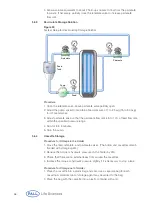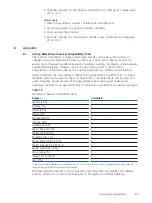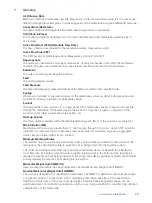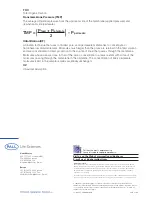
www.pall.com/biopharm
49
7.
Glossary
Air Diffusion Rate
Method to determine membrane cassette integrity. Also called Forward Flow value. It is the rate of gas
diffusing through the wetted pores, or bypassing seals of the membrane at a given differential pressure.
Concentrate (Retentate)
The feed solution remaining above the membrane during or after concentration.
CIP (Clean in Place)
Act of using a chemical cleaning protocol to clean the membrane and membrane assembly free of
any foulants.
Cross Flow Rate (CFR) (Retentate Flow Rate)
The flow of fluid across (parallel to) the membrane surface measured as L/min.
Cross Flow Flux (CFF)
The CFR per unit of membrane surface. Measured as L/min/m
2
(L/min/ft
2
).
Depyrogenate
The removal or inactivation of pyrogens (endotoxins, lipopolysaccharides) from within the membrane
cassette. Pyrogens are substances that cause a fever reaction when injected into mammals.
Endotoxin
The outer cell wall of gram-negative bacteria.
Feed
The starting sample volume.
Feed Pressure
The pressure (barg/psig) measured directly at the feed port (inlet) to the cassette holder.
Fouling
A build-up of retained or adsorbed species on the membrane surface resulting in decreased flux and
possibly an increase in retention of permeable solutes.
Foulant
The material that coats, adsorbs to, or plugs pores in the membrane causing a reduction in flow rate
through the membrane. The foulant may be the product or impurities (organic or inorganic) in the
product or from other sources like water, buffers, etc.
Hold-up Volume
The total volume contained within the feed/retentate flow path. (Most of this volume is recoverable.)
Microfiltration (MF)
Membranes with pore sizes greater than 0.1 microns (µm) through 10 microns. Used in TFF mode for
clarification or removal of micro particulates such as bacteria, mycoplasma, large virus, aggregates,
whole cells and cellular debris from a solution.
Minimum Working Volume
The (system) hold-up volume plus a minimum volume of liquid that must remain in the bottom of the
feed tank at the operating flow rate to prevent air from being drawn into the cassette system.
The minimum working volume limits the maximum concentration factor achievable. It is affected by
cross flow rate. At a higher cross flow rate, a greater liquid volume in the bottom of the feed tank is
required to prevent air from getting drawn into the pump. Tank design significantly affects the minimum
volume required to prevent air from getting into the system.
Molecular Weight Cutoff (MWCO)
Used in some documents; has been replaced by Nominal Molecular Weight Cutoff (NMWC).
Nominal Molecular Weight Cutoff (NMWC)
The pore size designation for ultrafiltration membranes. The NMWC is defined as the molecular weight
of a globular protein or solute which is 90% retained by that membrane after a 2X concentration.
Retention of molecules of the same molecular weight, but which have elongated shapes, can be
significantly lower. Concentration polarization, which occurs during ultrafiltration, can affect the retention
characteristics of the membrane.



































